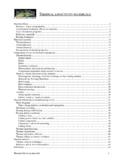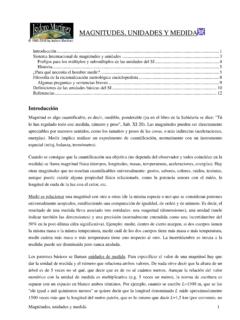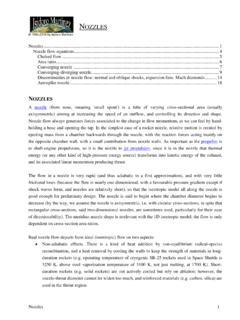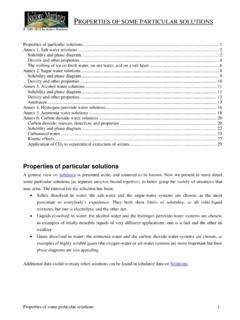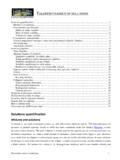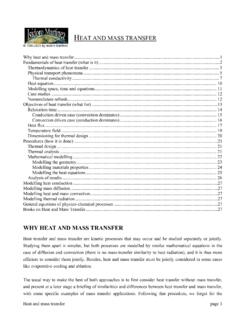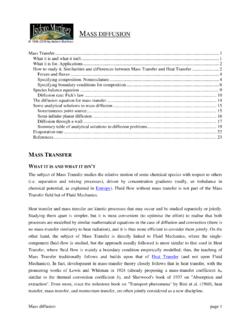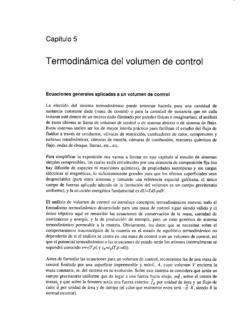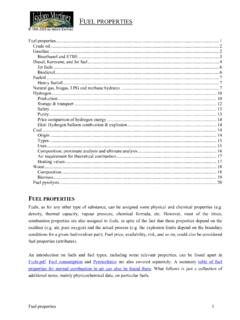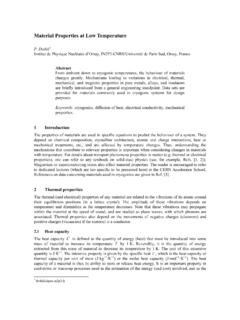Transcription of Heat transfer and thermal modelling
1 0 BHEAT transfer AND thermal RADIATION modelling . HEAT transfer AND thermal modelling .. 2. thermal modelling approaches .. 2. Heat transfer modes and the heat equation .. 3. modelling thermal CONDUCTION .. 5. thermal conductivities and other thermo-physical properties of materials .. 5. thermal inertia and energy storage .. 7. Numerical discretization. Nodal elements .. 7. thermal conduction 9. Multilayer plate .. 9. Non-uniform thickness .. 11. Honeycomb panels .. 12. modelling thermal RADIATION .. 13. Radiation magnitudes .. 14. Irradiance.
2 14. Power .. 14. Exitance and emittance .. 14. 15. Radiance .. 15. Blackbody radiation .. 17. Real bodies: interface .. 20. 21. Absorptance .. 22. Reflectance .. 23. Transmittance .. 24. Real bodies: 24. Absorptance and transmittance .. 24. Scattering .. 25. Measuring thermal radiation .. 25. Infrared detectors .. 26. Bolometers and micro-bolometers .. 28. Measuring thermo-optical properties .. 29. IR windows .. 30. Spectral and directional modelling .. 34. Two-spectral-band model of opaque and diffuse surfaces (grey surfaces) .. 34. modelling RADIATION COUPLING.
3 36. Radiation from a small patch to another small patch. View factors .. 36. Heat transfer and thermal radiation modelling page 1. Radiative coupling .. 40. Lumped network method (LNM) .. 41. Radiation distribution in simple geometries .. 44. Radiation from a point source to a large plate .. 44. Radiation from a small patch to a large 45. Radiation from a point source to a sphere, and how it is seen .. 47. Radiation from a small patch to a sphere .. 49. Radiation from a sphere to a small patch .. 50. Radiation from a disc to a small patch .. 51.
4 Summary of radiation laws .. 51. This is a briefing on thermal modelling of relevance to Spacecraft thermal Control (STC). A more detailed analysis of Heat transfer is presented aside. HEAT transfer AND thermal modelling . thermal problems are mathematically stated as a set of restrictions that the sought solution must verify, some of them given explicitly as data in the statement, plus all the implicit assumed data and equations that constitute the expertise. It must be kept in mind that both, the implicit equations (algebraic, differential, or integral), and the explicit pertinent boundary conditions given in the statement, are subjected to uncertainties coming from the assumed geometry, assumed material properties, assumed external interactions, etc.
5 In this respect, in modelling a physical problem, it is not true that numerical methods are just approximations to the exact differential equations; all models are approximations to real behaviour, and there is neither an exact model, nor an exact solution to a physical problem; one can just claim to be accurate enough to the envisaged purpose. A science is a set of concepts and their relations. Good notation makes concepts more clear, and helps in the developments. Unfortunately, standard heat transfer notation is not universally followed, not only on symbols but in naming too; for thermo-optical properties, three different choices can be found in the literature: A.
6 Suffix -ivity/-ance may refer to intensive / extensive properties, as for resistivity / resistance. B. Suffix -ivity/-ance may refer to own / environment-dependent properties; emissivity (own) /. absorptance (depends on oncoming radiation). This is the choice followed here (and in ECSS-E-ST- 31C- thermal control). C. Suffix -ivity/-ance may refer to theoretical / practical values; emissivity of pure aluminium /. emittance of a given aluminium sample. thermal modelling approaches A model (from Latin modulus, measure) is a representation of reality that retains its salient features.
7 The first task is to identify the system under study. modelling usually implies approximating the real Heat transfer and thermal radiation modelling page 2. geometry to an ideal geometry (assuming perfect planar, cylindrical or spherical surfaces, or a set of points, a given interpolation function, and its domain), approximating material properties (constant values, isotropic values, reference material values, extrapolated values), and approximating the heat transfer equations (neglecting some contributions, linearising some terms, assuming a continuum media, assuming a discretization, etc.)
8 modelling material properties introduces uncertainties because density, thermal conductivity , thermal capacity, emissivity, and so on, depend on the base materials, their impurity contents, bulk and surface treatments applied, actual temperatures , the effects of aging, etc. Most of the times, materials properties are modelled as uniform in space and constant in time for each material, but, the worthiness of this model and the right selection of the constant-property values, requires insight. Heat transfer modes and the heat equation Heat transfer is the relaxation process that tends to do away with temperature gradients in isolated systems (recall that within them T 0), but systems are often kept out of equilibrium by imposed boundary conditions.
9 Heat transfer tends to change the local thermal state according to the energy balance, which for a closed system says that heat, Q ( the flow of thermal energy from the surroundings into the system, driven by thermal non-equilibrium not related to work or the flow of matter), equals the increase in stored energy, E, minus the flow of work inwards, W; which, for the typical case of a perfect incompressible substance (PIS, constant thermal capacity, c, and density, ). without energy dissipation ( non-dis'), it reduces to: What is heat? ( heat flow) Q E W= E+ pdV Wdis= H Vdp Wdis=mc T|PIS,non-dis (1).
10 Notice that heat implies a flow, and thus 'heat flow' is a redundancy (the same as for work flow). Further notice that heat always refers to heat transfer through an impermeable frontier, the former equation is only valid for closed systems, and that heat transfer refers to a unique interface area (the whole frontier, or part of it under the continuum approach) but it cannot be associated to energy transfer by radiation between two bodies, 1 and 2 (unless all the heat flowing through frontier-1 also flows through frontier-2). The First Law applied to a regular interface (a non-dissipating one) implies that the heat loss by a system must pass integrally to another system, and the Second Law means that the hotter system gives off heat while the colder one takes it.
